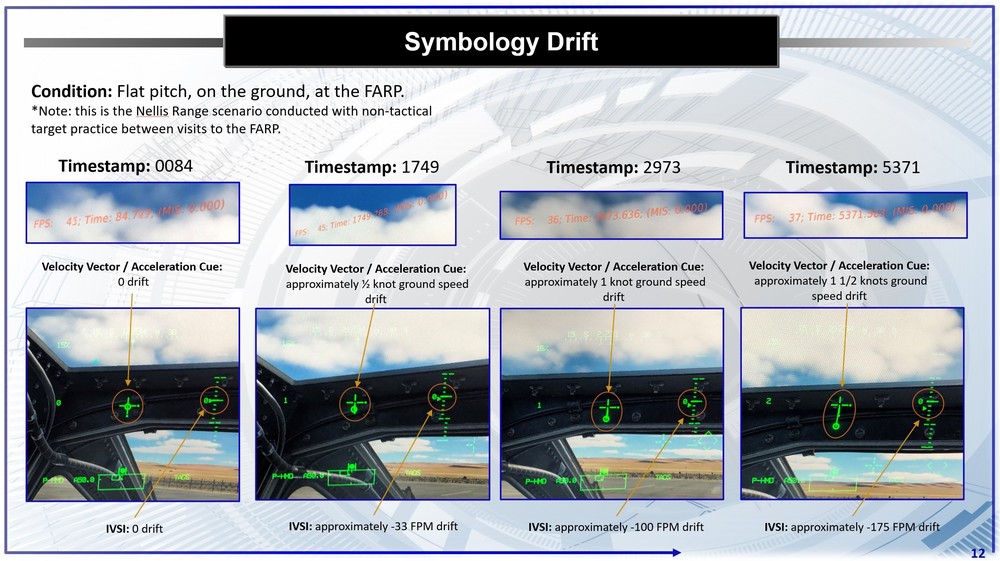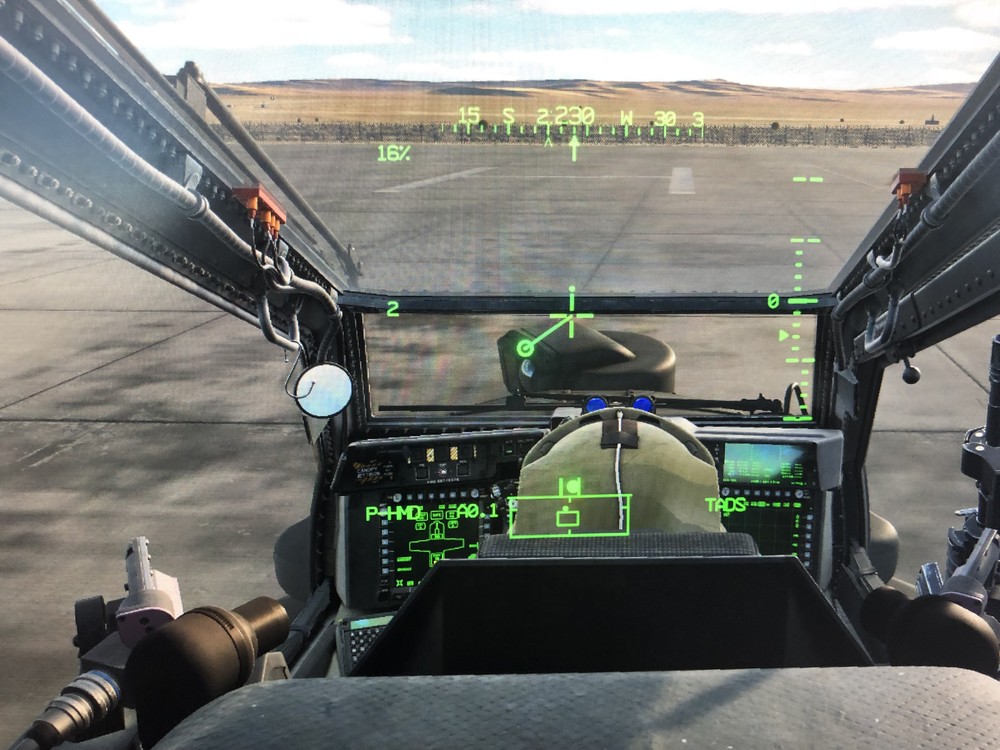-
Posts
36 -
Joined
-
Last visited
Content Type
Profiles
Forums
Events
Everything posted by Talonfox
-
Gents, ISSUE/DISCUSSION: When in flight with rockets selected the HDU will display a rocket steering cursor. Currently it is only displayed if the ARM/SAFE button is in ARM. In SAFE, an inhibited rocket steering cursor is displayed in the actual aircraft but not in the AH-64D module. RECOMMENDATION: Update the module to display an inhibited rocket steering cursor when rockets are WASed but the aircraft is SAFE.
-
•There are 3 TSD map orientation settings: north-up, track-up, and heading-up. •Selecting one of the settings on one MPD’s TSD page automatically transfers the setting to the other MPD’s TSD page in a given crew station. *This was confirmed in the actual aircraft 7 hours ago.
-

reported GPS not arresting INU velocity errors
Talonfox replied to Crptalk's topic in Bugs and Problems
Here is another sequence of symbology drift with associated timestamps. If needed I can DM the 45 MB track file. Best of luck to the troubleshooting team. -

reported Trim with slip indicator always nose left?
Talonfox replied to MstrCmdr's topic in Bugs and Problems
Concur with the aerodynamic modeling requiring constant trim adjustments depending on airspeed. It is a real thing but the problem is not quite solved as the yaw is still in excess of reality. -

reported Cued LOS dot in the Field-Of-Regard box
Talonfox replied to JSpidey's topic in Bugs and Problems
JSpidey is correct that the Cued LOS Dot remains in the field of regard even if the CPG SLAVE button is deactivated. -
ISSUE: The limits of the attitude indicator should be +-90 degrees. DISCUSSION: The limits of the attitude indicator displays "DIVE" on the pitch ladder upon exceeding 30 degrees nose low (see attached track file). The attitude indicator displays 90 degrees pitch nose up and 90 degrees pitch nose down around the lateral axis and 360 degrees around the longitudinal axis. Furthermore, experience from having trained 60 degree dives shows that the ladder itself has lines at -10, -20, -30, -45, and -60 (I'm assuming there is a -90 degree marker from what I've read, but I haven't seen it personally). RECOMMENDATION: Adjust the attitude indicator to include +-45 and +-60 before placing the "DIVE" at +-90. Barometric Altimeter & Pitch Ladder representations.trk
-
ISSUE: The barometric altitude on both the cruise symbology and the flight page show 1 foot increments (see attached track on the climb-out to 2000 MSL). DISCUSSION: The total range of barometric altitude is from -2300 to 20,000 ft, in 10 ft increments. RECOMMENDATION: Adjust the software to reflect 10 ft increments instead. Barometric Altimeter & Pitch Ladder representations.trk
-
The asterisk on the upper right MPD bezel button allows the pilot to toggle through three previously selected "favorite" pages with the single press of the button or by cursor selecting the adjacent digital *. This enables pilots to be able to cycle through critical pages without taking their hands off the controls. REQUEST: Enable this wishlist item when able.
-
ISSUE: Depressing the symbology select button on the cyclic the first time causes the flight page to display on the left MPD. Depressing it a second time does nothing. DISCUSSION: The first press works correctly, the second press should return the left MPD to whatever page was displayed before the flight page. RECOMMENDATION: Update the software to reflect the second press logic. Symbology Select 1 flight page 2 no change.trk
-

cannot reproduce and missing track file Rotor RPM Issues
Talonfox replied to derbarbarian's topic in DCS: AH-64D
In addition, it may be helpful to keep an eye on the torque value in the upper left corner, If you pull more torque than the "governor" allows, you will get a "rotor RPM low" annunciation. On the other hand, I can think of two scenarios which result in "rotor RPM high" : 1. an engine overspeed, and 2. rotor coning which occurs when excessive aft cyclic causes the rotor blades to flex upward and the rotor to spin faster. You can see the physics in action as an ice skater pulls their arms inward during a spin resulting in a velocity increase. Bottom line: Keep an eye on the torque and remember that a helicopter doesn't work the same way as DCS's high performance fixed-wing fighters. Good Hunting -

reported GPS not arresting INU velocity errors
Talonfox replied to Crptalk's topic in Bugs and Problems
I experienced a similar situation last night. After rebooting this morning, the symbology had returned to normal but after a short hour flight it began to drift again. I attached a screenshot of the condition while I was reloading at the FARP. Continuing to collect data on this anomaly. -
ISSUE: TAIL WHL UNLOCK SEL advisory message on the EUFD flickers between 19 & 21% torque (TQ) and is fully extinguished by 22%. DISCUSSION: One source states that when the message is presented the tail wheel unlock position has been selected. (This advisory is only presented when the aircraft is on the ground. In reality, the AH-64D generally ground taxis between 25-30% TQ and as the aircraft gets light around 40-50% the weight-on-wheels switch on the left main landing gear prompts the message to extinguish. Note: the UNLOCK pushbutton illuminates correctly. RECOMMENDATION: Adjust the software to turn off the advisory message at 45% instead of 20%. TAIL WHL UNLOCK SEL EUFD Message extinguishes during ground taxi.trk
- 1 reply
-
- 1
-

-
With Rockets WASed in the pilot station, the “RKT NORM” message is not displayed in the Weapon Status field of the High Action Display prior to an independent rocket engagement. After trigger pull, the “RTOF=NN” is accurately displayed. Also, when the rocket quantity available is 0, a “NO RKTS” message should be presented. No Rocket Norm HAD message .trk
-
Thoroughly enjoying the fidelity of this module! The flight model is superb for a beta release. The accuracy of the symbology is amazing, and the work that went into creating hyper-realistic MPD pages is astounding. Oddly, one thing that is a little off is the sight picture from the pilot station. The sight picture sitting at flat-pitch-ground appears as if no landing gear were installed with the aircraft belly contacting the ground. If the cockpit were raised up 5 feet, the picture would approximate the sight picture of the actual crew station in relation to the ground. Along those same lines, the sight picture at a 5 foot IGE hover appears low, too close to the ground. Conversely, the sight picture at 10 feet is more representative of the actual aircraft at a 5 ft. hover. It is likely that fixing the previous issue would also correct this one. While details like this would be insignificant and easily overlooked by some developers, ED's commitment to excellence and realism, demands that small adjustments like this receive attention. ED, we're all cheering as you knock this one out of the ballpark!
-
I would be onboard for that!
-
Icuham, point well made. If looking under the goggles is not an option in DCS then perhaps the SDU would be a viable option. Interesting background information and good on you for finding actual references. In reality, image intensification technology (I2) is being blended with FLIR to provide the best of all worlds, and in the future pilots may well be using a full-face visor with video presented on the visor itself. All exciting stuff. Once again, good work digging up the reference! Good Hunting!
-
Another technique that I teach to new pilots is to have a video page up on one of the MPDs. A video page mirrors both the symbology and the FLIR picture that would normally be displayed on the HDU combiner lens. NVGs down, the pilot still has the same basic cross-check (ie. center symbology, altitude, heading, picture, center symbology . . . ) and just glances down from time to time for the pertinent flight information. It just takes time and iterations to become proficient. Good Hunting
-
Recognizing that the hold modes are still in development and only the attitude hold is currently available, the flight controls tone played when attitude hold is disengaged is about twice as long as in the actual aircraft. The real flight controls tone is only about a second or so.
-
Helmet hanger hooks like those hanging off the crew station's left "go fast" handle are a type of after-market component and are found on some, but not all of the AH-64 fleet. Request: include a cockpit binding to turn it off, much like the ones that hide the controls when engaged.
-
Believe it or not, there was an effort a couple years ago to get rid of the bag all together and do all the NVS training at night. And if that wasn't enough, another program attempted to assess the viability of replacing part of initial common core training with VR. Both faded into history and FSXXI is still working a variant of the original AH-64D CMP circa 2002.
-
The bag is an irreplaceable but traumatic training phase. After more than 20 years IRL, I have more PTSD from 19 hours in the bag than in a hand full of combat deployments. Although, reading the public feedback would certainly be amusing if a bag training mission were to be incorporated into this module.
-
I just finished mapping the curser to a 4 way hat on my collective. It works like a champ even though it occasionally hangs up as it contacts the edge of the display. If you're looking for it, it looks like a green circle with a green "X" through the middle of it. You can see it in Figure 80 of the DCS AH-64D Quick Start Manual. Good hunting
-
AH-64s are not equipped with hooks or attachment points for sling loads.
-
Concur with a "trim recenter" option. Force trim in the real aircraft affects both the cyclic and the pedals but not the collective. To fix the pedal/heading instability I removed the springs from my Crosswind pedals and set the Pedals Trimmer Mode to "Joystick Without Springs and FFB". While I have to keep my feet on the pedals, I'm not fighting them and most of the erratic heading swings have subsided. As for the cyclic force trim--I've found that having the Controls Indicator displayed in the upper left corner. In addition, Wags just dropped a new video that addresses several issues including force trim (see timestamp 13:55) that you might find useful.





